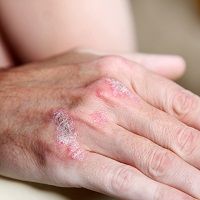Article
Psoriatic Arthritis More Common in Patients with Psoriasis than Previously Thought
Author(s):
Several symptoms, including nail pitting and uveitis, may indicate an increased risk for developing psoriatic arthritis.

A prospective cohort study indicates that psoriasis patients develop psoriatic arthritis at a higher rate than previous studies have reported.
Investigators obtained and analyzed up to 8 years of data from 464 patients in the Toronto Psoriasis Cohort who had been diagnosed with psoriasis by a dermatologist. They evaluated patients at baseline for inflammatory arthritis, enthesitis, and spondylitis and excluded patients who showed signs of articular involvement.
Patients were reevaluated annually and cases of psoriatic arthritis were diagnosed according to criteria from the Classification of Psoriatic Arthritis Study group by 2 rheumatologists, who reviewed clinical records, lab results and images. Investigators then used multivariable Cox proportional hazards models to estimate the relative risk (RR) of psoriatic arthritis onset associated with a number of factors.
A total of 51 of those patients developed confirmed cases of psoriatic arthritis during the follow-up period. Another 9 patients had suspected cases of psoriatic arthritis based upon questionnaire answers.
Subsequent multivariable analysis found that a number of baseline variables were associated with an elevated risk of psoriatic arthritis: severe psoriasis (RR, 5.4; p = 0.006), less education (university/college graduate vs high school dropout, RR, 0.22; P = 0.005; high school graduate vs high school dropout RR, 0.30; P = 0.049), and use of retinoid medications (RR, 3.4; P = 0.02). In multivariate models with time-dependent variables, the factors associated with an increased risk of psoriatic arthritis were psoriatic nail pitting (RR, 2.5; P = 0.002) and uveitis (RR, 31.5; P = 0.0002).
<!--page-->
“The incidence of psoriatic arthritis in patients with psoriasis is higher than previously reported,” the study authors wrote in Arthritis & Rheumatology. “A severe psoriasis phenotype, presence of nail pitting, low level of education, and uveitis are predictive of the development of psoriatic arthritis in patients with psoriasis.”
The results of the new study echo those from other recent research.
For example, a meta analysis of psoriasis patient studies that was published last year in the Journal of the American Academy of Dermatology also found an unexpectedly high level of psoriatic arthritis in psoriasis patients.
None of the studies that the meta analysis authors reviewed explicitly attempted to quantify the prevalence of undiagnosed psoriatic arthritis, but 7 epidemiological studies and 5 studies of arthritis screening tools provided the necessary data for diagnoses to be made after the fact. The combined results of all the studies indicated that 15.5% of all psoriasis patients had undiagnosed psoriatic arthritis. The combined results of just the epidemiological studies put the estimate at 10.1%.
Another recent trial used magnetic resonance imaging (MRI) as a tool for identifying factors that might predict new cases of psoriatic arthritis in psoriasis patients.
Investigators performed high-field MRI scans on 55 patients with psoriasis (but not psoriatic arthritis) and another 30 healthy controls. They then scored each scan for synovitis, osteitis, tenosynovitis and periarticular inflammation according to the psoriatic arthritis magnetic resonance imaging scoring (PsAMRIS) method.
Results on these initial MRI scans were strongly associated with each psoriasis patient’s risk of developing psoriatic arthritis. Some 60% of the patients with subclinical synovitis and symptoms related to arthralgia — but only 13% of patients who began with normal MRI results and no reported arthralgia — went on to be diagnosed with psoriatic arthritis at some point during the follow-up period.





